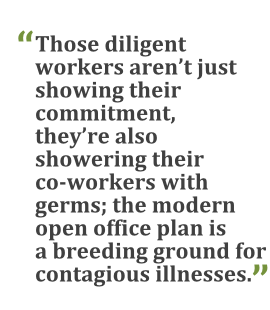There's nothing more selfish you can do than come towork sick. You may get a gold star for showing yoursniffling face at the office and soldiering through theworkday to prove your value—but everyone around you just gets sick.You're an inconsiderate work hazard.
|When people bring their infectious illness to work, itspreads—and when sick people don't have a financial incentive toshow up to work, fewer people get sick, according to a newworking paper by the nonprofit National Bureau of EconomicResearch.
|The researchers studied U.S. cities with paid sick-leavemandates and, using Google Flu Trends data at the cityand state level from 2003 to 2015, looked for changes in flurates after those mandates went into effect. The cities thatadopted paid sick-leave mandates in that timeframe saw flu cases drop by about 5 percentafter their laws took effect. For a city of 100,000people, that comes out to 100 fewer infections per week, theresearchers estimate.
| “Yousee people who are at the workplace sneezing and potentiallyinfectious. That's how diseases spread,” said Nicolas R.Ziebarth, an assistant professor at Cornell University and one ofthe study's researchers.
“Yousee people who are at the workplace sneezing and potentiallyinfectious. That's how diseases spread,” said Nicolas R.Ziebarth, an assistant professor at Cornell University and one ofthe study's researchers.
For most of us, staring at a computer through the fog ofillness is torture and does nothing to help usrecover. Yet 3 million people, or 2 percent of the U.S.population, bring their ailments to work each week—aphenomenon the researchers dubbed ”contagiouspresenteeism.”
|Many do so because of financial pressures; nearly athird of workers have no access to paid sick leave,according to the Bureau of Labor Statistics. The othertwo-thirds, who have the luxury of taking a sick day, need tostop making excuses for showing up at work sick.
|Almost half of workers say they worry work will pileup if they stay home sick. People who find their jobsengaging also have a hard time staying home, finding workmore fun than submitting to the reality of a sick day.
|“Some people want to appear tough and signal that they arehard-working,” said Ziebarth.
|But those diligent workers aren't just showing their commitment,they're also showering their co-workers with germs; the modernopen office plan is a breeding ground for contagiousillnesses. Worst of all, people tend to come to the office at thebeginning of an illness, when they're at their most contagious butstill feeling well enough to get a little work done.
|“You have over-the-counter drugs that suppress yoursymptoms, but they don't suppress contagiousness,” Ziebarth pointedout.
|Employers, for their part, should encourage ailing workers tostay home. Presenteeism—showing up at work ill, whether they'recontagious or not—costs companies about $150 billion a year, onestudy estimated. A worker is about a third as productive whenhe's slumped in a desk chair working at half-speed as heis when he's healthy, say researchers. By staying home when he'ssick, he can get better faster. The rest of theworkforce can remain in full—and fullyproductive—health.
|And diligent workers who absolutely must meeta deadline or finish a life-or-death project shouldat least self-quarantine. Telecommuting has become anincreasingly acceptable way to work, and 60 percent ofemployers let employees work from home, according to theSociety for Human Resource Management's annual Employee BenefitsSurvey.
|“It's good to change the culture of how people see each other,”said Ziebarth. “You can signal hard work in a lot of differentways. It's not the right way to go into the office and spreaddiseases.”
|In fact, we all need to do our part to stigmatize coming towork sick. If a co-worker comes in complaining of a tickle inhis throat or clammy hands, say: “Go home! Nobody wantsyou and your gross germs.”
|Or just send him a link to this article.
|Copyright 2018 Bloomberg. All rightsreserved. This material may not be published, broadcast, rewritten,or redistributed.
Complete your profile to continue reading and get FREE access to Treasury & Risk, part of your ALM digital membership.
Your access to unlimited Treasury & Risk content isn’t changing.
Once you are an ALM digital member, you’ll receive:
- Critical Treasury & Risk information including in-depth analysis of treasury and finance best practices, case studies with corporate innovators, informative newsletters, educational webcasts and videos, and resources from industry leaders.
- Exclusive discounts on ALM and Treasury & Risk events.
- Access to other award-winning ALM websites including PropertyCasualty360.com and Law.com.
*May exclude premium content
Already have an account? Sign In
© 2024 ALM Global, LLC, All Rights Reserved. Request academic re-use from www.copyright.com. All other uses, submit a request to [email protected]. For more information visit Asset & Logo Licensing.







